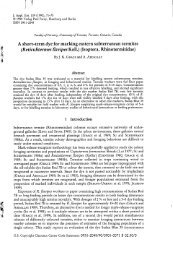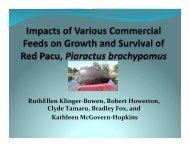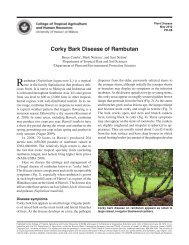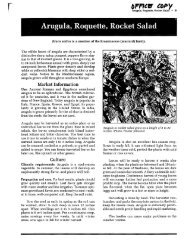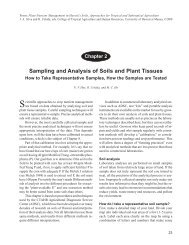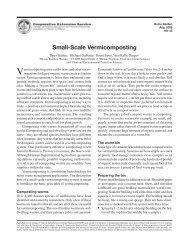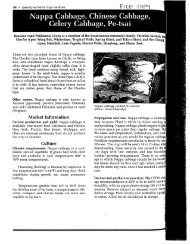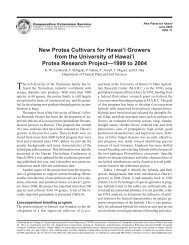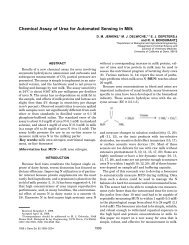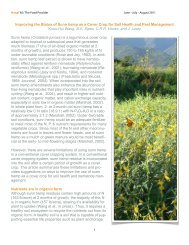Macadamia Nuts in Hawaii: History and Production - ctahr ...
Macadamia Nuts in Hawaii: History and Production - ctahr ...
Macadamia Nuts in Hawaii: History and Production - ctahr ...
You also want an ePaper? Increase the reach of your titles
YUMPU automatically turns print PDFs into web optimized ePapers that Google loves.
Before us<strong>in</strong>g any herbicide, read the entire label<br />
carefully <strong>and</strong> follow the directions exactly.<br />
Animal graz<strong>in</strong>g is not recommended because of<br />
nut contam<strong>in</strong>ation by animal refuse.<br />
Pest Control<br />
Insects. Although <strong>in</strong> its <strong>in</strong>digenous area of<br />
Australia the macadamia does have many economically<br />
serious <strong>in</strong>sect pests (44), <strong>Hawaii</strong> has<br />
only a few that need to be attended to.<br />
The larvae of the koa seed worm, Cryptophlebia<br />
illepida (Butler), <strong>and</strong> those of the litchi fruit moth,<br />
C. ombrodelta (Lower), feed upon the nut husks,<br />
<strong>and</strong>, if the shells are soft, will bore through <strong>and</strong><br />
damage the kernel (52,53). C. illepida, an <strong>in</strong>sect<br />
native to <strong>Hawaii</strong>, is parasitized by several natural<br />
enemies, whereas C. ombrodelta, be<strong>in</strong>g an immigrant<br />
species, has only a few enemies. S<strong>in</strong>ce chemical<br />
control of these <strong>in</strong>sects is difficult <strong>and</strong> not<br />
economically feasible, field sanitation <strong>and</strong> the<br />
elim<strong>in</strong>ation of alternate hosts, such as acacia, are<br />
recommended.<br />
The southern green st<strong>in</strong>k bug, Nezara viridula<br />
(L<strong>in</strong>naeus) (43), was a major pest <strong>in</strong> the 1960s,<br />
but, with the <strong>in</strong>troduction of several predators <strong>and</strong><br />
parasites, it has been brought under reasonable<br />
control, <strong>and</strong> chemical control of this <strong>in</strong>sect is not<br />
recommended.<br />
The red-b<strong>and</strong>ed thrips, Selenothrips rubroc<strong>in</strong>ctus<br />
(Giard), <strong>and</strong> the <strong>Hawaii</strong>an thrips, Taeniothrips<br />
hawaiiensis (Morgan), periodically develop<br />
<strong>in</strong>to epidemic proportions. Damage to flowers<br />
reduces yield substantially. Leaves may also be<br />
damaged, caus<strong>in</strong>g yellow<strong>in</strong>g. The <strong>in</strong>sects do not<br />
normally attack young nuts, but older nuts may be<br />
spotted with the silvery dried excrement of thrips.<br />
This damage is of no significance. Wettable malathion<br />
can be applied at 2 to 4 pounds peracre orto<br />
a drip-wet state <strong>in</strong> which spray quantity is difficult<br />
to judge. With the emulsifiable concentrate, 1 to 2<br />
p<strong>in</strong>ts per acre is allowed with no time limitation<br />
on its use. However, s<strong>in</strong>ce malathion is toxic to<br />
honeybees, application should be made early <strong>in</strong><br />
the morn<strong>in</strong>g when bee activity is low. Phosalone<br />
(Zolane), an organic phosphate <strong>in</strong>secticideacaricide,<br />
has been registered <strong>in</strong> <strong>Hawaii</strong> for use <strong>in</strong><br />
mite <strong>and</strong> aphid control, <strong>and</strong> is applied at 4 to 8<br />
p<strong>in</strong>ts per acre per year.<br />
Other <strong>in</strong>sects such as ants, beetles, mealybugs,<br />
<strong>and</strong> scales are of m<strong>in</strong>or economic importance.<br />
Stored macadamia nuts, sometimes <strong>in</strong>fested by<br />
beetles, can be treated with methyl bromide when<br />
necessary.<br />
Mites. Two species of mites, the broad mite,<br />
Polyphagotarsonemus latus (Banks), <strong>and</strong> the red<br />
<strong>and</strong> black flat mite, Brevipalpus phoencis<br />
(Geijskes), cause damage to flowers with some<br />
symptomatic tann<strong>in</strong>g of husks <strong>and</strong> leaves (21).<br />
Wettable sulfur has been found to effectively control<br />
the mites. One large grower has been apply<strong>in</strong>g<br />
wettable sulfur at 10 pounds per acre by air <strong>and</strong><br />
ground once or twice a year dur<strong>in</strong>g the flower<strong>in</strong>g<br />
season to reduce the buildup of the mite population.<br />
Morestan miticide has been cleared for use <strong>in</strong><br />
macadamia a t the ra te of 1 to 8 pounds per acre.<br />
Three applications per season may be made, up to<br />
the day of harvest. Plictran 50W miticide was given<br />
a supplemental label to meet a special need <strong>in</strong><br />
<strong>Hawaii</strong> to control broad mites affect<strong>in</strong>g macadamia<br />
nuts. Four to 6 ounces of Plictran 50W per<br />
100 gallons of wa ter are used. It is applied as 200 to<br />
400 gallons of spray mixture us<strong>in</strong>g conventional<br />
spray equipment. The miticide should be applied<br />
when the broad mites appear <strong>and</strong> repea ted as necessary.<br />
The use restrictions on the label specifically<br />
say not to apply more than 6 pounds of Plictran<br />
50W per acre per season, or more than four applications<br />
per season, <strong>and</strong> not to apply it with<strong>in</strong> 14<br />
days before harvest.<br />
The mite predators Metaseiulus occidentalis<br />
(Nesbitt) <strong>and</strong> Amblyseius cali/omicus (McGregor)<br />
were released <strong>in</strong> two large orchards <strong>in</strong> 1978. As of<br />
1982, these predators have not been recovered.<br />
Diseases. Currently, only three economically<br />
important diseases affect macadamia. These are<br />
the two flower blights, caused by Botrytis c<strong>in</strong>erea<br />
(25,26,38,39,84) <strong>and</strong> Phytophthora capsici (40),<br />
<strong>and</strong> a root rot organism, Kretzschmaria clavus (34,<br />
35,37), especially prevalent <strong>in</strong> <strong>and</strong> associated with<br />
the wet areas of Hilo <strong>and</strong> Pahoa.<br />
1. Botrytis c<strong>in</strong>erea is a blossom blight that establishes<br />
itself only on senescent floral tissues<br />
of macadamia; affected flowers do not develop<br />
<strong>in</strong>to mature fruits (Fig. 72). This disease<br />
is especially prevalent <strong>in</strong> <strong>Hawaii</strong> dur<strong>in</strong>g<br />
the w<strong>in</strong>ter months, when the humidity<br />
approaches 95 percent <strong>and</strong> the temperature<br />
is between 61 ° <strong>and</strong> 72°F <strong>in</strong> the flower<strong>in</strong>g<br />
season.<br />
2. Phytophthora capsici is especially prevalent<br />
dur<strong>in</strong>g a prolonged wet period. It is a water<br />
mold fungus that <strong>in</strong>fests the immature raceme<br />
even before the floral structures are<br />
55



